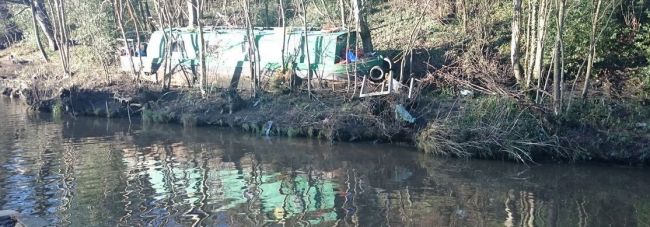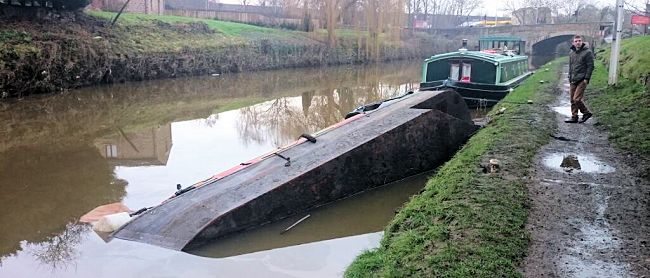How to winterise your narrowboat
With winters getting colder and sub-zero
temperatures becoming more common, River Canal Rescue has put together some
tips on how to winterise your narrowboat and so avoid costly repair bills.
Cooling systems
Just like vehicles, any ‘closed loop’ cooling
system needs to have anti-freeze added and replaced (per manufacturer’s
guidelines). Not only will this minimise
the risk of splits or fractures associated with freezing water, it will improve
the engine’s cooling efficiency and minimise corrosion risk to the engine.
Where raw water (drawn from the river)
cooling systems are in place, drain down by briefly running the engine when out
of the water to ensure the system is empty.
If afloat, the quickest and simplest solution is to ‘shut off’ the inlet
valve (seacock) and drain as much water from the system as possible.
Where no drain plug is available, disconnect
a hose, drain the water from the system and leave disconnected. Although this will not empty the system completely,
it will allow for expansion should the water freeze and reduce the risk of
ruptured pipes. It’s also worth insulating any accessible tight bends as this
is where fluid will collect even after draining. Once you’re ready to start
cruising again, reconnect any pipes, refill the system and open the seacock.
If the engine’s winterised or seacock’s
closed, clearly mark the engine and its controls; it should prevent accidental
operation.
General checks
Check lockers, cockpit and other areas to ensure
all drain holes and plugs are clear of debris, leaves, dirt etc. These areas
block easily and in heavy or prolonged rain, can cause a vessel to take on
water causing corrosion where the water’s left sitting or even worse, sinking.
Always
test the bilge pump and if possible, invest in an automatic one – it’s far more
reliable than a manual. Many of the sunken vessels attended over the summer
would still be afloat if they had an automatic pump fitted. An automatic bilge
pump immediately responds to water ingress with the float switch dictating when
it should pump. Should a leak develop from cooling system, hull or other source
(or there’s a build up of rain water), this will keep your vessel safe.
Regular checks to ensure batteries are
charged are vital. Test the battery charge levels before leaving the boat and when
you return or before a long journey. Heavy rainfall, leaking stern glands and
issues with weed hatches can result in water ingress that quickly fills the
boat and causes it to sink. If batteries go flat at a critical point it can be
devastating.
Grease the stern tube before leaving the boat,
this will prevent water ingress. Although
most stern glands leak once the propeller turns, the grease acts like a seal
whilst not in use.
Water in a boat will cause it to be lower in
the water, placing outlets such as those for a shower, sink or air vent, nearer
to the water level (leading to catastrophic results!).
Ensure boat mooring pins and ropes are secure,
yet slack enough to deal with the normal rise or fall of water levels. Where
possible attach a long rope to a tree or higher ground, so that if flooding
occurs, or the boat becomes loose in high winds, the additional rope could
provide a much-needed safety line. In
extreme weather or prolonged rainfall, visit the boat regularly to adjust
mooring ropes and check bilge pumps and batteries are coping with the
situation.
It’s also a good idea to run the engine for
an hour every time you visit as this pushes oil around the engine and prevents
rusting, plus it tops up the battery if left running long enough (beware of
doing this if you’ve drained the cooling system!).
Spray terminals with a silicone-free
lubricant and grease all available grease points on the engine and drive, plus
electrical connectors. Also lubricate linkages and gear/throttle slides, this
will prevent rusting/corrosion and give these components a longer life.
Generators
If not in use, store in a gas-tight locker –
the same regulations as Liquid Petroleum Gas (LPG) apply.
Water and heating
Freezing temperatures can cause split or
fractured pipes which, if left over a gradual period, can lead to complete or
partial flooding.
Drain down the water system (including
drinking water and cistern) and leave taps in the open position. Most water heaters have a screw plug at their
base and can accommodate an old-fashioned cycle pump which makes the emptying
of water that much quicker.
Taps should be left open because if any water
is left in the system and it freezes, the pressure on the pipes will be less
due to air coming out of the taps.
An unnoticed pipe split and flooding will
almost certainly lead to sinking which may not be covered by insurers (not all
cover frost damage and a gradual incursion of water may not be classed as accidental).
If covered, insurance policies normally insist ‘machinery is winterised
according to manufacturers’ recommendations’.
If not available, the advice of a qualified engineer should be sought. Taking no precautions is asking for trouble.
Lag your hot and cold pipes and top up
anti-freeze in keel cooling and other sealed heating systems (such as radiators
connected to the boiler). This point is
repeated because it’s the single most important thing to do, whether your
narrowboat is being used over the winter period or not.
Protecting possessions
Remove or put out of site any alcohol, valuable
and electrical items. If you have a
secure mooring this might not be such an issue, but if in doubt, take it out.
Invest in decent locks, your insurance policy
requires this and it’s more likely to deter thieves. Ensure all windows and
access points are firmly closed and locked before leaving the vessel and visit
regularly. Prevent the theft of external
items, such as mushroom vents, solar panels and chimneys, by fixing with extra-strength
sealant and invest in security shear nuts.
Ask neighbouring boats to call if they have any concerns.
Diesel treatment
Excessive
water in the tank can lead to water feeding through the fuel system (RCR regularly
removes large quantities of water from fuel tanks in the early cruising season).
To prevent this;
Regularly
check your filler cap seal and replace if worn, cracked or damaged. The cap
sits lower than the deck so if it’s been raining wipe away excess water before
opening the cap.
Either
leave the tank empty during winterisation and remove any water on your return
or leave the tank full and treated*.
*Fuel
treatments remove water and deal with contamination such as diesel bug - where enzymes,
bacteria etc live off the water in diesel and affect the diesel properties. Inactive boats are more at risk of growth
developing in the fuel tanks so treat with Marine 16 Diesel Fuel Complete.
Freezing weather & ice
If
the boat’s encased in ice and you’re worried about the effects on the hull take
care…breaking the ice can result in more damage than simply leaving it. The
only time the ice should be broken is if you need to move, and this should be
only undertaken with caution. The stress
on the hull from a large surface area of ice is huge and at a minimum will cause damage to the blacking.
Don’t forget to de-winterise
Having gone through the winterisation process,
it’s important to do the reverse when the warmer weather arrives. This means closing the taps, replacing the
plug in the water heater and switching the water pump on.
Prior to cruising, run your engines up to ‘running’
temperature (if a gauge is available onboard) or for approximately 1/2 hr. Check every inch of the cooling system for
leaks or escaping steam and if something is found, immediately call-out a
qualified engineer.
For domestic water supplies; once the water
pump is back on, open and run water through each tap. Start with those closest to the pump and work
through to the one furthest away – this’ll push any air locks through the
system. Drain any water in the tank out
and refill with fresh drinking water.
Remember servicing, including the engine, LPG
and electrical systems, plus fire extinguishers and escape hatches. Everything should pass Boat Safety Scheme
scrutiny.
Although no action is needed for gas pipes at
the start of the winter, it’s a good idea to paint connections with 50% soap
liquid and 50% water using a small artist’s brush – this will show up any minor
gas leaks at the joints.
Before you run the engine, check water trap
filters and remove any excess water. If
water is present or there are signs of diesel bug (black dust or jelly), dip
the tank to identify the severity of the issue and then treat with a fuel
treatment or have the fuel polished accordingly.
The
easiest way to check for water in the tank is to use a clear plastic hose. Drop it into the tank (being careful not to
disturb the fuel) and when you feel the bottom, place your thumb over the end
to seal it and withdraw the hose. This should provide you with a sample of the
tank (plus an indication of any diesel bug contamination) and show the amount
of water present.

 been sunk, stranded ashore or damaged. River Canal Rescue River reports (8th January) that it’s been inundated with calls to help raise and refloat sunken craft and remove vessels that have been swept onto land or each other by unprecedented water levels and are now trapped. The breakdown and assistance firm is currently dealing with 20 cases and notifications are coming in on a daily basis from agencies and boat owners across the UK. The widespread damage to the canal and river networks in Yorkshire, Lancashire and Greater Manchester, particularly the Aire, Calder, Hebble and Rochdale canals, has resulted in a concentrated area of devastation spanning 20-30 miles.
been sunk, stranded ashore or damaged. River Canal Rescue River reports (8th January) that it’s been inundated with calls to help raise and refloat sunken craft and remove vessels that have been swept onto land or each other by unprecedented water levels and are now trapped. The breakdown and assistance firm is currently dealing with 20 cases and notifications are coming in on a daily basis from agencies and boat owners across the UK. The widespread damage to the canal and river networks in Yorkshire, Lancashire and Greater Manchester, particularly the Aire, Calder, Hebble and Rochdale canals, has resulted in a concentrated area of devastation spanning 20-30 miles.









